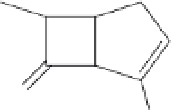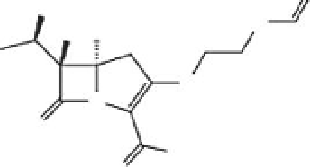Chemistry Reference
In-Depth Information
H
N
O
COOH
FIGURE 9.12
The core carbapenem structure.
NH
2
HO
H
H
1
5
8
6
2
H
3
C
S
4
N
7
3
O
CO
2
H
FIGURE 9.13
The structure of thienamycin.
cattleya
. Thienamycin has high potency, broad spectrum, antibacterial activity, and
relatively high resistance to β-lactamases. The discovery of thienamycin represented
a new family of β-lactam antibiotics and more than 40 natural carbapenem antibiot-
ics have been isolated.
Most of the naturally occurring carbapenem antibiotics have a 1-hydroxyethyl
group on C6. The configuration differences at the chiral center, C8, result in epimers.
Due to the low isolation efficiency and multiple products formed under fermentation
conditions, all carbapenem antibiotics for clinic use are produced by total synthesis,
although this leads to a high cost compared to producing penicillin and its deriva-
tives directly from fermentation.
Although thienamycin is high in potency and resistant to β-lactamases, its insta-
bility is a limiting factor in clinic use. Thus, more chemically modified carbapenem
antibiotics were synthesized and several carbapenem antibiotics, for example, imipe-
nem (Figure 9.14), have been marketed.
NH
OH
HN
H
H
S
N
O
OH
O
FIGURE 9.14
The structure of imipenem.










Search WWH ::

Custom Search